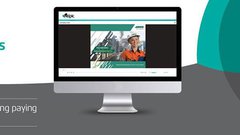The new e-Learning paradigm
Published 28-JUN-2016 10:36 A.M.
|
6 minute read
Hey! Looks like you have stumbled on the section of our website where we have archived articles from our old business model.
In 2019 the original founding team returned to run Next Investors, we changed our business model to only write about stocks we carefully research and are invested in for the long term.
The below articles were written under our previous business model. We have kept these articles online here for your reference.
Our new mission is to build a high performing ASX micro cap investment portfolio and share our research, analysis and investment strategy with our readers.
Click Here to View Latest Articles
The rise of learning management systems and e-Learning for use in business shows no signs of abating. Statistics highlight the adoption of e-learning methodology will only become stronger in the coming years.
It is estimated that between the years 2015 and 2020, the LMS market will grow by about 180%, with an estimate of growth from $4.07 billion in 2015 to $11.34 billion in 2020, roughly an annual growth rate of 22.8%.
While LMS (learning management systems) and eLearning isn’t new, technological capabilities have made eLearning more accessible.
“As long as there has been internet there has been online training,” says Russell Francis CEO of cloud-based eLearning provider Velpic.
“This was limited by infrastructure and poor broadband service in the early days to roll out truly novel solutions, but companies like SAP have been in there from day 1 with the technology.
Francis says another barrier to entry for businesses looking for LMS solutions was cost.
“When eLearning first came on the scene it was cost prohibitive and only available to the top end of town. SAP and other providers were instigating seven figure projects only large companies could afford and put into practice.”
The technology has improved since then. Software as a Service (SaaS) means cost is no longer prohibitive, but, depending on your needs, a must have business tool.
And it has positive implications for those looking for cost-effective in-house training tools.
“Technology is at the point where businesses can implement SaaS-based models, this means LMS can be introduced to a whole new size of business, from one man operations to big business,” Francis tells Finfeed.
“There is significant growth in LMS. This is an industry expected to be worth over $11 billion globally by 2020.”
Suffice to say it is a rapidly growing marketplace.
What is driving business to adopt cloud-based training models is their need to drive business efficiencies, whilst reducing costs to the business. Francis says that by using an online system to train staff, businesses can typically save 70% of the cost of non-cloud based training and he’s even seen savings as high as 99% at one client moving from traditional classroom based inductions to online inductions.
Where Velpic would have been a multi-million dollar endeavour only 10 years ago, and most likely unviable as a business when compared to the SAPs of this world, it is now a growing business with a cost effective training solution relevant to all businesses.
In May 2016, Velpic launched Version 3.0 of its eLearning platform, knowns as the SME platform.
At the time of release Francis said, “Version 3.0 marks a key point in the Company’s growth trajectory, with the SME version now the ignition point for the globalisation of Velpic’s platform.”
We clearly live in an on-demand economy. Therefore cloud-based systems provide an ideal solution to several business functions including accounting, project management, marketing and staff training.
“The real benefits do come from these services being on-demand,” Francis says. “Businesses no longer have to wait to get things done and in terms of instructional content there is now a greater depth that negates the cost for many types of traditional training.”
Velpic works with content providers, who provide content for everything from workplace harassment to sales training. There is a balance between commoditised lessons and the white label lessons businesses can create using Velpic’s tools and then brand them as they see fit.
Francis says traditional methods of training will always be relevant, but there is a rise of blended learning.
“There will always be certain situations where you have to touch, feel and poke, but the vast majority of education is commoditised.”
As an example of this Francis cites the current trend for Registered Training Organisations (RTOs) to encourage students to complete their prerequisite training online, so they are prepared for classroom lessons.
Lessons follow-ups can also be completed online, saving time for both student and teacher, whilst cutting costs and keeping the student involved with the subject matter.
“LMS embeds and underscores retention of the subject matter,” Francis says.
Businesses are taking the same approach and Velpic is examining the need for LMS systems in a range of global industries.
LMS is the perfect tool for SMEs, with Velpic’s technology offering a set and forget solution.
“We do the whole thing in one package suitable for everyone from an owner-driver, to one or two people responsible for training 500-1000 people,” Francis says.
“Velpic is the only LMS that allows you to create the content, schedule the lessons to the right people at the right time on any device and management can report on who did what, where and when.”
In this multi-billion dollar industry, Velpic has developed an aggressive roadmap to expand its product globally and maintain a first mover advantage in the way it delivers content.
The company’s success in such a short time highlights the LMS movement.
“Initially there was a development team, myself and salesperson and we listed on the ASX and raised $4million to put into the business. In just a short few months we have a full presence in all states and NZ and a mix of enterprise sales and a growing digital presence.
To help with the digital facet of the business, Velpic brought Leanne Graham on board, who had significant success with Xero.
“When we brought on Leanne Graham, we were looking at bringing in someone with real gravitas. We felt if we were to be a global business, we needed a real presence. I cold called her and she did a huge amount of due diligence, then took the position of Chair.
“With Leanne on board we also pivoted from a traditional enterprise sales model and added a SaaS friendly partnership pillar and SME pillar.”
For Velpic the second half of 2016 is all about customer growth and acquisition. Its first major move in this sphere occurred in March when the company secured an agreement with ADP, a leading provider of cloud-based HCM solutions with more than 630,000 clients and 35 million end-users spread across over 100 countries.
This numbers alone hint at the size of the addressable LMS market.
According to elearning.com there is significant growth rates across the globe as shown below:
- India: 55%
- China: 52%
- Malaysia: 41%
- Romania: 38%
- Poland: 28%
- Czech Republic: 27%
- Brazil: 26%
- Indonesia: 25%
- Colombia: 20%
- Ukraine: 20%
It is worth noting that while in 2012 the top buyers of mobile learning products and services where US, Japan, South Korea, China, and India, it is expected that by 2017 the top buyers of mobile learning products and services will be China, US, Indonesia, India, and Brazil.
While Velpic won’t capture this entire market, its technology, pending patents and unique platform could provide a springboard into these regions.
General Information Only
S3 Consortium Pty Ltd (S3, ‘we’, ‘us’, ‘our’) (CAR No. 433913) is a corporate authorised representative of LeMessurier Securities Pty Ltd (AFSL No. 296877). The information contained in this article is general information and is for informational purposes only. Any advice is general advice only. Any advice contained in this article does not constitute personal advice and S3 has not taken into consideration your personal objectives, financial situation or needs. Please seek your own independent professional advice before making any financial investment decision. Those persons acting upon information contained in this article do so entirely at their own risk.
Conflicts of Interest Notice
S3 and its associated entities may hold investments in companies featured in its articles, including through being paid in the securities of the companies we provide commentary on. We disclose the securities held in relation to a particular company that we provide commentary on. Refer to our Disclosure Policy for information on our self-imposed trading blackouts, hold conditions and de-risking (sell conditions) which seek to mitigate against any potential conflicts of interest.
Publication Notice and Disclaimer
The information contained in this article is current as at the publication date. At the time of publishing, the information contained in this article is based on sources which are available in the public domain that we consider to be reliable, and our own analysis of those sources. The views of the author may not reflect the views of the AFSL holder. Any decision by you to purchase securities in the companies featured in this article should be done so after you have sought your own independent professional advice regarding this information and made your own inquiries as to the validity of any information in this article.
Any forward-looking statements contained in this article are not guarantees or predictions of future performance, and involve known and unknown risks, uncertainties and other factors, many of which are beyond our control, and which may cause actual results or performance of companies featured to differ materially from those expressed in the statements contained in this article. S3 cannot and does not give any assurance that the results or performance expressed or implied by any forward-looking statements contained in this article will actually occur and readers are cautioned not to put undue reliance on forward-looking statements.
This article may include references to our past investing performance. Past performance is not a reliable indicator of our future investing performance.






